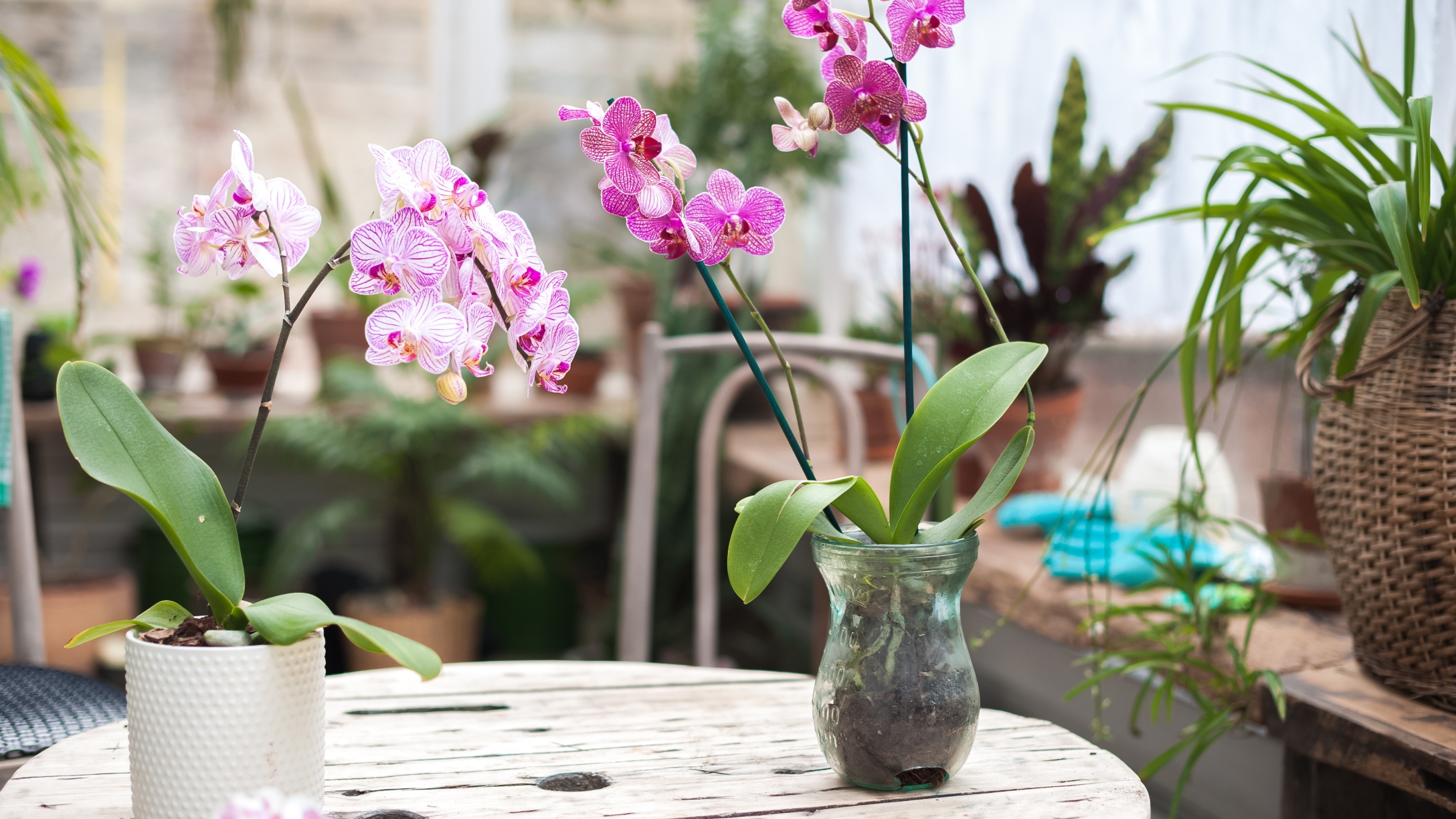
What is your favorite kind of flower? Do you love a traditional red rose, or do you always keep an eye open for delightful daisies? Maybe you have a soft spot for classic chrysanthemums or prefer petunias. Do you swoon over bouquets with baby's breath and always remember to give forget-me-nots a little appreciation? Of course, there are so many more fabulous flowers around, such as tulips, orchids, violets, and snapdragons, just to name a few!
Indeed, while there's a very good chance that you've spent plenty of time looking at various types of flowers, along with smelling flowers and even gardening with flowers, have you ever stopped to think about how and why they got their names? As Shakespeare wanted to know, would a rose by any other name smell as sweet? Beyond that, would a flower be any cooler if you knew the oh-so-intriguing trivia behind its moniker? Yes, it really would. So read on to find out why some of your favorite flowers ended up with their names!
Forget-Me-Not
These vivid little blue wonders have only been known by their current name since around the 19th century. Before that, the coiled-looking plant that sports blue and white petals with a bright yellow center was called scorpion-grass, according to Plant Life. The flower is often thought of as a “symbol of love,” and wearing a forget-me-not means that your love is always thinking of you. Aw!
Orchid
Orchids have been a wonder on this planet for about 80 million years and were even studied extensively by Charles Darwin. The flower alone brings class to any room, but the origin of the orchid’s name is a lot less dapper. In Greek, an orchid is actually called orkhis, which translates to “testicle” and comes from the testes-like shape of its root.
Daisy
The unmistakable look of a vibrant white and yellow daisy makes you think of bright, sunny days. That's surely why the word daisy comes from the Old English word dægesēage, which means “days eye.” Beyond that, the name more than likely has to do with the fact that daisies commonly close their petals at night and then expand when the sun comes out.
Crocus
The wonderfully tubular-shaped petals of the crocus can be seen in stunning lavender, yellow, or mauve, but it’s what grows from the very middle of the flower that makes this plant so special. Native to the “Alps, southern Europe, and the Mediterranean area,” according to Britannica, the name crocus actually means “saffron.” The highly expensive, bright red herb comes from the purple crocus (Crocus sativus) and is so pricey due to the fact that each flower produces only a small amount.
Daffodil
Daffodils are native to Europe, but their name is specifically connected to a legendary Greek story. The proper name of the daffodil is narcissus, according to Merriam-Webster, and comes from the myth involving a figure named Narcissus who fell in love with his own reflection after seeing it in a pool of water. Just like the man in the myth, the head of the daffodil flower tends to bend as though it is looking down.
Petunia
Unfortunately for the fragrant petunia, its name traces back to a less-than-desirable-smelling plant. Apparently, the name of the flower derives from the old French word petun, which when translated means “tobacco,” according to Merriam-Webster. Now, that doesn’t mean that you can start lighting up the little plant, as it's named so because it's related in a botanical sense to tobacco.
Lupines
These tall beauties, which are surprisingly a part of the pea family, have a name with quite a fierce origin. Lupine comes from the Latin word lupinus, which means "wolf." But why the animal-like moniker? It's due to the fact that the plant was once thought to devour all the minerals from the soil around it like a wolf devours its prey.
Tulip
Tulips don't happen to get their name from the fact that their petals resemble two lovers kissing (as in two lips), although the different colors do have certain symbolic meanings. Yellow represents cheerfulness, purple is for royalty, white is for forgiveness, and red represents everlasting love. Instead, the name tulip comes from the Turkish word tülbent, which means “turban,” because the shape of the petals resembles the headwear.
Violet
The origin of the violet’s name can be connected to vilolete, a French word from the 12th century, which is when it began to be used to describe the unique bluish-purple color. Beyond that, the vibrant violet has a connection to chemistry, specifically the chemical iodine, which is a term that comes from the Greek ioeides, or “violet-colored,” for the violet flame that's visible while burning.
Lotus
The sacred lotus, which is a type of water lily, can be traced back to Egyptian times when the fruit of the flowers was used for food and making wine, which was “thought to produce contentment and forgetfulness,” according to Britannica. It is also the flower mentioned in Homer’s Odyssey that was eaten by Lotophagi, causing “drowsiness and euphoria.” The beautiful lotus, which gets its name from the Latin word of the same name, receives the nutrients it needs from plunging its roots deep into the mud. It is said to symbolize rebirth, as its flowers rebloom every morning.
Anemone
The blooms of the colorful anemone are popular for bridal bouquets and are also associated with keeping away evil, as the petals of the flower close up as rain approaches. In an ancient Greek myth, an anemone, which is the Greek word for “windflower” (how sweet is that?), sprang from the tears of Aphrodite when she was saddened by the loss of her love, Adonis, according to Flower Meaning (so, not so sweet after all).
Aster
The name of the aster flower has many ties to stories from around the globe, such as Greek mythology, English folklore, and Cherokee legends. The name of the tiny daisy-like delights comes from the Greek, meaning “star,” which is something that resembles the beam-like petals of the plant.
Snapdragon
Not only is the snapdragon a wonderfully unique flower to look at, but it’s also a lot of fun to say. The name itself comes from the fact that the flowers on the snapdragon plant look like the head of the mythical creature. However, the actual scientific name is Antirrhinums, which is from the Greek word meaning “nose-like,” according to Florgeous.
Gladiolus
The gladiolus has a rich and dramatic history. The colorful flower grows in a sheath-like fashion up its stem and is referenced in the book Naturalis Historia, a text written by 1st-century Roman naturalist Pliny the Elder. He aptly named the bloom gladiolus, which in Latin means “little sword,” according to Florgeous.
Hydrangea
The full, puffy blooms of the hydrangea come in a variety of different colors that change depending on the pH levels of the soil that they are growing in. The name hydrangea was coined in 1739 by the botanist Grovonius, who, according to Collins Dictionary, combined the Latin words for “water” (hydro) and “vessel” (angeion), because of the water pitcher-like cups that grow from the plant.
Lilac
The sweet-smelling lilac has a history that is rooted in Greek mythology. When the goat-like god Pan was trying to woo the nymph Syringa, she had to turn into a lilac bush in order to escape his pursuit. When Pan couldn’t find his love, he instead stumbled on the lilac bush and cut one of the hollowed reeds to create his famous panpipe. According to FTD, the name lilac is from the Spanish and French name of the same origin, but the scientific name is Syringa vulgaris, borrowed from the Greek word syrinks, meaning "pipe."
Peony
Peonies have been used as symbols of honor and nobility in China, wealth and fortune in Japan, and protection in Greece. According to HGTV, the name of the bulbous plant originates from the story of the Greek god of medicine, Asclepius, who was turned into a flower after trying to kill his talented student, Paeon. Yikes!
Poinsettia
Poinsettias have long been a popular floral choice around Christmastime due to their large red and green leaves. The plants hail from Mexico, where they bloom in the month of December, while the name poinsettia actually comes from Dr. Joel Roberts Poinsett, who was the first United States minister to Mexico and introduced the poinsettia to America.
Chrysanthemum
Chrysanthemums, or what are commonly known as “mums,” were first grown in China around the 15th century. According to the National Chrysanthemum Society, when introducing the flower to the Western world in 1753, a Swedish botanist named Karl Linnaeus linked the Greek words chrysos (gold) and anthemon (flower) because early depictions of chrysanthemum were shown to be very yellow and in need of a lot of sunlight.
Hyacinth
Greek mythology loves to use flowers as symbolism, and the name of the hyacinth can be traced back to an ancient story of love and jealousy. According to Flower Meaning, Apollo, the sun god, and Zephyr, the wind god, were competing for the love of a young man named Hyakinthos. Apollo was teaching Hyakinthos to throw a discus when Zephyr, in a jealous rage, sent a gust of wind in Apollo’s direction that blew the discus back at Hyakinthos, striking and killing him. Grief-stricken, Apollo noticed a flower bloom from the spilled blood of his love and named it “hyacinth” after him.
Rhododendron
The rhododendron, although very beautiful, has some killer properties. The flower is terrific at attracting pollinators but can be extremely poisonous as it contains a toxin called grayanotoxin in its pollen that has been linked to mad honey disease. The name itself, however, has a sweeter meaning. Because of the flowery blooms, the moniker comes from the Greek words rhodos (rose) and dendron (tree), according to Britannica.
Lily
Both a beautiful flower and a popular name, lily has become symbolic of chastity, purity, and virtue thanks to stories linking the plant to Greek myths about springing from the milk of the goddess Hera and being associated with the Virgin Mary. According to Online Etymology Dictionary, lily comes from the Latin word lilium, and when used as an adjective, lily can mean “white, pure, lovely or pale, colorless.”
Carnation
Carnations have many meanings, depending on which color you choose. According to the Online Etymology Dictionary, the meaning of the name carnation may be as varied as its colors. For instance, the Latin word carnationem means “fleshiness,” referring to the original pink color of the flower, while some think the moniker stems from coronation, or from the word corone, meaning flower garlands.
Lavender
The lovely-smelling lavender, with its distinct color, is actually part of the mint family and is used mainly for herbaceous-smelling oils. The name lavender actually has roots in the old French word lavendre, as well as from the Latin lavare, which means “to wash.” That definitely suits, thanks to the fact that the fragrant flower was used by ancient Romans to add to baths or to wash clothing, according to Britannica.
Foxglove
When you first hear the name of this native European plant, you may envision a rather refined little red fox with fancy paw wear, but the beautifully cupped pink and purple flower can actually be quite deadly if ingested in even small doses. The name foxglove is said to come from the Anglo-Saxon "foxes glofa (the glove of the fox), because its flowers look like the fingers of a glove,” according to Encyclopedia.
Baby’s Breath
Baby’s breath is a cute little pink or white flower that is commonly used as filler in wedding bouquets and other floral arrangements. According to Dictionary, the name comes from its “delicate odor and bloom.” However, it's also synonymous with any plant of the genus Gypsophila, which “thrive on soil high in gypsum, a mineral that makes the soil too thick and heavy for many other types of plants,” and can commonly symbolize “self-discipline and fidelity,” according to Flower Meaning.
Jasmine
The wonderfully fragrant white star petals of the jasmine flower are used for essential oils and to bring lovely smells to any garden. Jasmine is also the national flower of Pakistan, while its name is derived from the Persian word yasmin, which means “gift from God,” according to Flower Meaning.
Azalea
Azaleas are part of the Rhododendron family and were first grown in China and Japan. The flower of the azalea can be amazingly beautiful in shades of pink, red, orange, or purple, but like the rhododendron, they are quite poisonous. The lush and vibrant azalea gets its name from the Greek word azaleos, or “dry,” because of its ability to grow in lighter soil.
Impatiens
Impatiens were originally grown on the island of Zanzibar and in Africa before making their way west around 1896, according to the University of Vermont. Also called touch-me-not or busy Lizzy, the name of the plant does not come from the anticipation of waiting for their flowers to grow, but instead, impatiens is the Latin word for “impatient,” which is due to how easily the ripened seeds of the plant fall off at the slightest touch (yes, it's the seeds that are impatient).
Mimosa
The word mimosa is often associated with the orange juice and sparkling wine drink enjoyed at weekend brunches; however, the name of the mimosa flower has a very different origin. Mimosa comes from the Latin mimus, which translates to the English word “mime.” This is well-suited for the mimosa flower due to the fact that when is it touched, the petals turn in as they mimic the behavior of a shy animal, according to the Online Etymology Dictionary.




